


 النبات
النبات
 الحيوان
الحيوان
 الأحياء المجهرية
الأحياء المجهرية
 علم الأمراض
علم الأمراض
 التقانة الإحيائية
التقانة الإحيائية
 التقنية الحيوية المكروبية
التقنية الحيوية المكروبية
 التقنية الحياتية النانوية
التقنية الحياتية النانوية
 علم الأجنة
علم الأجنة
 الأحياء الجزيئي
الأحياء الجزيئي
 علم وظائف الأعضاء
علم وظائف الأعضاء
 الغدد
الغدد
 المضادات الحيوية
المضادات الحيوية|
Read More
Date: 30-10-2015
Date: 28-10-2015
Date: 5-11-2015
|
Beneficial animals
Since time immemorial, human beings have used animals for food and other purposes. While some animals are very useful to mankind certain others cause loss to the economy of man. Though every organisms has its own importance in nature, some of them such as a few mammals, birds, fishes, prawns and insects have become valuable. Some pests are competitors of human beings for natural resources and food. Thus a study of economically important animals will always be useful.
1-Beneficial animals
The animals contributing to our economy and welfare are known as beneficial animals. Many animals provide us with nutritious food like meat and milk, clothing materials like silk and wool and the luxurious items like pearls and corals. The silk worms, the honey bees, the lac insects, fowls, fishes, prawns and crabs belong to this category.
1-1 Corals - reef builders
Most of us know about corals and are not familiar with their biology. Coral rocks are actually the skeletal remains, primarily of calcium carbonate secreted by living coral polyps. The coral organisms belong to the phylum: Coelenterata.
All reef building corals live as large colonies. Reef corals are typically shy, nocturnal feeders. During the day, polyps are withdrawn into skeletal cups and the corals appear more or less lifeless. But at night time the whole reef magically comes to life and coral polyps stretch out their tentacles, probing the waters for food. The reef looks like a field of flowers.
Reef forming corals grow only in shallow, tropical seas where the temperature of the water never falls below 20o c. Only in warmer waters, the coral polyps can extract calcium from the sea water and deposit it as calcium carbonate in their skeletons. Corals thrive only in crystal clear water.
Small plants like Zooxanthella living in the coral tissue contribute to the yellow, brown and green colours of some reef forming corals. The brighter red and orange colours are created by pigment cells in the body wall.
Formation of coral reefs
Corals are best known for the massive rocky reefs they build in tropics. The corals spread by producing vast number of minute ciliated larvae called Planulae, through sexual reproduction. These larvae initially lead a free swimming life. Later they settle on rocks and start new colonies of polyps by repeated fission or budding. A coral reef is thus a result of the activity of millions of coral polyps over several thousand years.
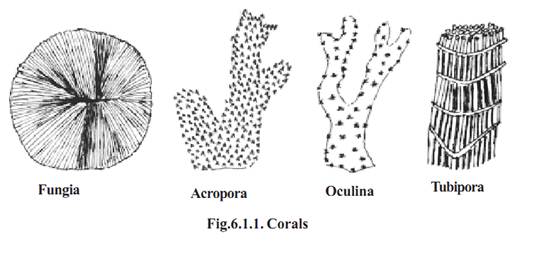
Coral reefs are of three types namely, Fringing reefs, Barrier reefs and Atolls. In India coral reefs occur in the Lakshadweep, Andaman and Nicobar Islands and in the south east-coast.
Fringing reefs form shallow shelves in shallow waters at or near the shore of the mainland or around offshore Islands. At the southern end of Indian peninsula, this type is seen as a chain of well-developed reefs starting from Rameshwaram Island and extending beyond Tuticorin. They are also present in the Gulf of Kutch on the west coast of India.
Barrier Reefs are situated away from the coast and form off-shore break waters parallel to the coasts or isolated islands. The famous Great Barrier reef of North Eastern Australia which is 2012 kilometers long, is the largest of its kind.
Atolls consist of a ring shaped reef, encircling a shallow lagoon which is connected to the outside by an opening. Hawaii and Carribian Islands are famous for Atolls.
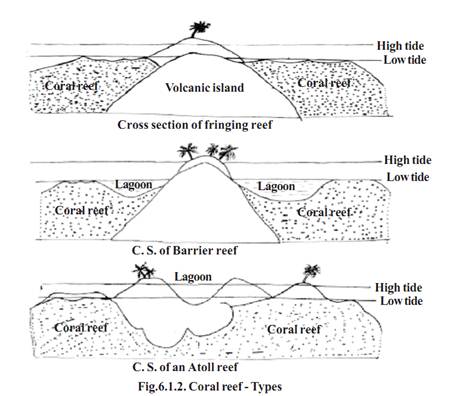
Economic importance
Some corals are highly priced for their decorative value. Precious corals like Corallium Nobile (= C. rubrum) are used in jewellery and ornaments. Corals are also important in building the coral reefs and islands, some of which are used as habitation by human and other animals. The organ pipe coral (Tubipora) is used in indigenous system of medicine in South India
Coral skeletons especially of species like porites are used in as building construction and for metalling their roads. Corals serve as raw materials for the preparation of lime mortar and cement because of their calcium carbonate content. Some older coral lime stones are rich in magnesium, hence they are of great value in making cement. Coral skeletons act as natural barriers against sea erosion and cyclonic storms. Old reefs have long served as sea bird sanctuaries and have collected huge deposits of bird droppings (guano).
Coral reefs provide a unique habitat for large and diverse variety of organisms. The richness of the invertebrate fauna and the complex structure of the coral reefs have provided opportunities for the evolution of a number of fishes associated with coral reefs.
In several countries Fringing reef, Barrier reef and Atolls are helping in the tourism industry.
1-2 Earthworm - Vermiculture
The growth of industries, urban cities and the ever increasing human population has led to an increased accumulation of waste materials. Waste materials introduced into the environment are of two types namely non-degradable and degradable wastes. The disposal of these solid wastes remains serious challenge in most of the countries.
Waste biomass from agriculture, domestic, urban and industrial sources remains the main cause of organic pollution in many countries, including India. Degradable or decomposable materials constitute a major percentage of the refuse (more than 60%).
New technologies are now available for recycling some of these solid wastes. These wastes can be utilized in vermitechnology for the production of earthworm casts and earthworm tissue protein.
India produces about 2500 million tonnes of organic wastes annually. If properly managed about 400 million tonnes of plant nutrients can be produced from this huge organic wastes.
Vermiculture :-
In recent years vermiculture has received much attention in many countries. The spiralling cost of fish meal and the low supply of soybean meal are responsible for the utilization of earthworms as an alternative low cost protein meal in aquaculture and poultry industry. Further the worms also play an important role in waste disposal. They decompose natural organic wastes into rich compost fertilizer. A single earthworm can produce 1000 to 1500 offspring in a year. 2000 mature breeders can produce more than 1 million worms in a year.
Selection of earthworm species and their culture
Lampito mauritii and Perionyx excavator are cultured in India and Thailand. Helodrilus foetidus and Lumbricus rubellus are distributed worldwide. Amynthas hawayana, Eisenia foetida and Eudrilus engeniae are also commonly used for waste management.
The methods of culturing earthworms can vary from place to place. A cultured worm must be able to adapt to substrates, grow fast and breed or multiply readily under controlled conditions.
A compost pile bed of 2.4m long, 1.2m wide and 0.6m deep appears to be very satisfactory for a population of more than 50,000 earthworms. The boxes can be made from wood (51cm long, 36cm wide and 15 cm deep) to accommodate 5000 to 6000 worms. Soil, organic matter, manure, leaves, rice straw, dried water hyacinth, saw dust and any fermented substrate can be used as a culture medium to raise worms in boxes or containers.
The worms in the worm beds can grow and reproduce faster if they are given sufficient food. Any decayed organic matter appears to be good food for worms but the feed should not be contaminated by detergents or insecticides.
Since the earthworms are rich in protein (65%), fat (14 %), carbohydrate (14 %) and ash (3%) they are used as a feed component for fish, prawn and shrimp. They are also used as livestock feed in poultry industry.
Vermicompost
Many species of earthworms are easily adaptable to agricultural wastes like after harvest strubble, sugarcane thrash, coirwaste, dung of cow, horse, sheep and poultry droppings. The breakdown of these materials or the degrades of organic matter by worm activity is called ‘Vermicompost’ It is a better source of organic manure.
1-3 Beneficial Insects
Insects affect man’s welfare in many ways. Many insects are beneficial to man. Beneficial insects are divided into two main groups according to the nature of benefit derived from them. They are Productive and Helpful insects.
I. Productive Insects
These insects produce certain substances which are useful to humans. The important useful insect products are Honey, Silk and Lac.
A. Honey bee
Honey bees are social insects. They live as colonies. They are active throughout the year. They feed on the pollen and nectar of flowers. In India there are four different varieties of honey bees. Of these, only three species are useful in collecting honey.
1- Apis dorsata (Rock bee). This is the largest of the Indian honey bees. It produces plenty of honey. It builds large open single combs which may often be four feet long on tall forest trees. It is not possible to domesticate them for the bee keeping industry.
2-Apis florea : This is the smallest of the three species and is known as the little bee. It builds single combs, which are very small. They are found hanging from bushes and corners of roof.
3-Apisindica : This is the common Indian honey bee. Its size is intermediate between A. dorsata and A. florea. This bee builds several parallel combs. generally in hollows of trees, on the walls, inside wells, caves and similar protected spots. This is the only Indian honey bee capable of domestication.
The honeybees collect nectar from various flowers. The nectar is swallowed by the bees. In its stomach due to the action of enzymes certain changes happen to the nectar. Later in the bee hive it is regurgitated and stored in chambers as honey.
Apiculture or Bee keeping is the technique of rearing honey bees for honey and wax from their comb or beehives.
Uses of Honey and Bees wax
Honey has a high nutritive value. Its colour and smell varies in accordance with the nectar collected from different flowers.
It is estimated that 200g of honey provides as much nourishment as 11.5 liters of milk or 1.6kg cream or 330g meat. One gram of honey provides approximately 33k.cal of energy. Honey has laxative, antiseptic and sedative characteristics. It is used in Ayurvedic and Unani systems of medicines. It is helpful in building up the hemoglobin of the blood. It prevents cough, cold, and fever. It cures ulcers on tongue and alimentary canal. It is also used in the preparation of bread, cakes and biscuits
Beeswax is also a natural secretion of the worker bee from the glands located in the abdomen. It is used in the manufacture of cosmetics, face creams, paints, ointments, insulators, plastic works, polishes, carbon paper and many other lubricants. It is also used in microtomy for block preparation of tissues.

Silk is another valuable product from the insect world. The silk is obtained as fine threads from the cocoons of various species of silkworms. Sericulture is the scientific management of production and marketing of natural silk from silkworms.
Types of Silk worms
1-Mulberry silkworm - Bombyx mori : This is a completely domesticated insect. Since the natural food of this worm is mulberry leaves, it is called mulberry silk worm. The silk produced by this moth is white in colour. It is called the mulberry silk.
2-Tasar Silk worm: Antheraea paphia
This caterpillar feeds on ber, oak, sal and fig plants. The cocoon produced by this worm is smooth and hard. It is of hen’s egg size. The cocoon yields reelable, brown coloured Tasar silk.
3-Muga Silk worm: Antheraea assamensis: The native place of this species is Assam where it has now become a good source of cottage industry. The silk produced by this moth is known as Muga silk.
4-Eri Silk worm: Attacus ricinii
The caterpillar of this worm feeds on castor leaves. The cocoons of this worm have very loose texture and the silk produced is called as Arandi silk locally. The threads are not glossy but much durable.
The sericulture plays a significant role in the rural economy of our country. The Chinese have the credit of discovering silk. It was kept as a secret for several centuries. India now occupies a unique position in the world for its rich sericigenous fauna to produce pure mulberry silk as well as the three other varieties of non-mulberry silks.
Uses of silk
The raw silk is used in the manufacture of woven materials, knitted fabrics and garments. It is also used in parachutes, parachute cords, fishing lines, as sieves in flour mills, insulation coil for telephones and wireless receivers, and tyres of racing cars.
C. Lac insects
Another useful product we get from insects is lac. Lac is the resinous protective secretion produced by a kind of scale insect called Laccifer lacca. They secrete a brown resinous substance called the lac. The minute red coloured larva of this insect, settles on succulent shoots of the host plants. While growing they secrete a resinous material which covers them. The twigs are harvested and the encrustations scraped, dried and processed to yield the lac of commerce.

The important trees needed for lac encrustation are the kusum, the Ber, Palas, Babul and sal. These trees are common in the western ghats.
Uses of lac
Lac is one of the most versatile natural resinous materials. It has a unique combination of properties which render it useful in the plastics, electrical, adhesive, leather, wood finishing and other industries. In the electrical industry it used in the form of insulating varnishes and moulded insulators. It possesses very good adhesion to mica. It is an ingredient of varnishes, polishes, finishes wood used for protective and decorative purposes. It is a principal ingredient of sealing wax. It is also used in the manufacture of glazed paper, printing and water proof inks, nail polishes, dental plates, ammunition, bangles, wax crayons and optical frames.
II. Helpful Insects
This category of insects includes all forms which by their life activities help man in controlling the plant and animal pests. The most important of these helpful insects are the insect feeding or entomophagous forms including predators and parasites. These are important in maintaining a balance in insect populations.
Insect - Predators
These are generally larger than their prey. They can pounce upon and devour the prey easily. Among the insect predators, lady bird beetles are more useful to the farmers and gardeners. These small beetles are voracious and are highly prolific and long-lived. Both larvae and adults feed on a wide range of insects. Other common and well known predators are Aphis lions and ground beetles.
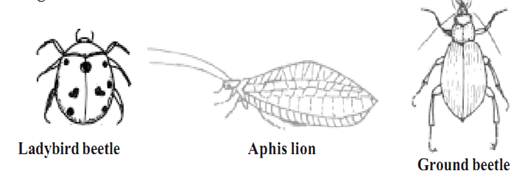
Fig. 5. Insect - predators
Insect parasites
Are smaller than their hosts. They live continuously for at least a part of their lifecycle on or within the body of the host. The tachinid flies parasitize caterpillars, beetles and other groups of insects. The braconids are a large group of small wasp-like insects that parasitize a wide range of insects including plant lice and caterpillars. Most groups of insects are plagued by ichneumon parasites.
Employing insect predators and parasites for controlling the population of insect pests is known as biological control.
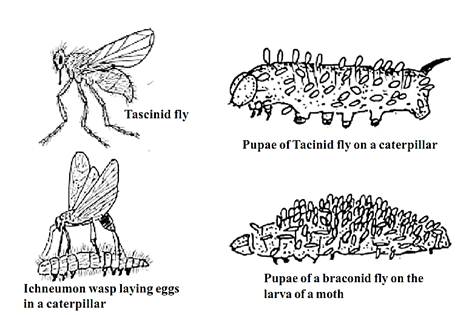
Fig. 6- Insect parasites
Insects as pollinators
Insects play an important role in the pollination of plants. Bees, wasps. Ants, butterflies, beetles and thrips render valuable service in pollination. The services of honey bees are needed in the production of cultivated crops, such as apples, pears, plums and vegetables. Some plants like the yucca and Smyrna fig are completely dependent upon insects for pollination.
Other useful insects
A number of insects feed on plants and they may aid in keeping plant weeds under control. The most successful use of an insect in the control of a plant was the introduction of the caterpillar of a moth (cactoblastis cactorum) to control the prickly pear (Opuntia spp) in Australia.
1-4-Prawns, Lobsters and Crabs
A. Prawns
The prawns are one of the most economically important fishery organism of India. It helps to earn a sizeable amount of foreign exchange. The prawns are the most esteemed food among the marine food organisms. Therefore, they are in great demand both in the local and international markets.
Export of ‘prawn pulp’ to Burma and Malaya from earlier times and ‘frozen and canned’ prawns to USA and Japan in recent years has made Indian prawns a major foreign-exchange earner. Apart from being a delicacy, prawns are a rich source of protein and vitamins (A and D). They contain considerable quantities of glycogen and free amino acids in their muscles imparting their flesh a sweet taste. As they contain very little fat, they have become a favorite protein food for the weight conscious persons.
Indian prawns of commercial importance
Penaeus indicus, P. monodon, P. japonicus, Metapenaeus dobsoni, M. monoceros M. affinis, M. brevicornis, Parapenaeopsis stylifera, P. sculptilis, Macrobrachium rosenbergii , M. malcomsonii, Palaeomon tenuipes and P. styliferus

Fig. 7. Prawns
Freshwater prawns inhabit rivers and lakes across the entire country. They migrate to brackish water for breeding. Eg. Macrobrachium, Palaeomon. Marine prawns occur in shallow coastal waters. They form large shoals close to Malabar Coast during the monsoon season. Penaeus, Parapenaeopsis and Meta penaeus are the important genera of the Indian coast. The practice of rearing prawns as a ‘secondary crop’ between November and April in the paddy fields along the coastal areas in India should be a step towards increased production of fresh water prawns.
Fresh prawns are packed in ice and sent to inland markets for consumption. Large specimens are frozen directly between layers of ice. Smaller varieties are boiled, shelled and then packed between ice. Prawns are also cured. This includes sundrying, salting and pickling.
B. Lobsters
Lobsters belong to four main groups. They are clawed or true lobsters, spiny or rock lobsters, sand or slipper lobsters and coral lobsters. The lobsters of our country are called spiny lobsters. The economically important species of spiny lobsters are Palinurus polyphagus P. homarus, P. ornatus and P. versicolors. The lobsters are called (Kal Eral) in Tamil.

Fig. 8. Lobsters and crabs
The lobster fishery of India gained importance only recently. Its food value (proteins 15-24 %) was realized following the demand for lobsters in western countries. India is one of the prominent countries in spiny lobster marketing. The main lobster landing centres in India are Mumbai, Veraval, Kolachal, Tuticorin, Chennai, Mandapam and Kozhikode. North west coast contributes 80-90 percent of the landings with P. polyphagus being the dominant species. On the west coast P. polyphagus and P. homarus are very common and on the east coast P. polyphagus and P. ornatus are common. In the Gulf of manner the lobster fishery is confined to the areas where coral reefs are present. The lobsters are caught throughout the year but the peak fishing season is December to January.
The lobsters are esteemed as good food particularly in foreign countries. Therefore most of the lobster catches are exported to USA, Canada, UK, France, Spain, Belgium, Gulf countries, Nepal and Singapore.
The central Marine fisheries Research Institute (CMFRI) has carried out studies on fishery, recruitment, biology, physiology, breeding, larval rearing and culture of economically important spiny lobsters in India.
C. The Crabs
The crabs are decapod crustaceans. They are characterized by the greatly enlarged cephalothorax. The abdomen in crabs shows sexual dimorphism. In males the abdomen is narrow. In female crab the abdomen is broad. and it carries eggs during breeding season.
There are nearly six hundred crab species occurring in the Indian waters but only very few of them are being used for food purposes. The important species of crabs supporting the fishery are Matuta lunaris, Scylla serrata, Portunus sanguinolentus, and Charybdis cruciata.
1-5-Pearl Oyster
Pearls are one of the rarest and highly esteemed gems. Pearls are produced by the pearl oysters of the genus Pinctada under class Bivalvia. From the point of view of pearl production in Indian waters, the most important species is P.fucata. It has a wide distribution in the Persian Gulf, Red sea, Gulf of Kutch, Gulf of Mannar and the Palk Bay. The oysters occur on ridges of rock or dead coral in the Gulf of Mannar along both coasts of India and Sri Lanka. These formations are known as ‘pearl banks’ or ‘paars’. They extend from Cape comorin to Rameshwaram Island. Heavy production had been recorded in Tuticorin.
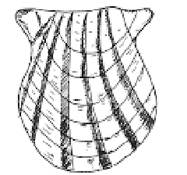
Fig. 9. Pearl Oyster
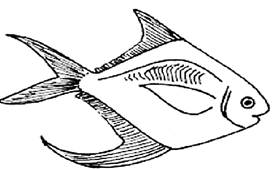
Fig.10. Pomfret
From each pearl oyster bed thousands of oysters are taken out. Every oyster contains a pearl. Most of the pearls obtained are too small. Some of them are large, perfectly round with fine lustre fetching high prices. Hence it is worthwhile farming oysters and induces pearl formation. In recent years India has succeeded in developing farming techniques for the production of cultured pearls of good shape and lustre.
The CMFRI in India gives necessary training in pearl culture techniques. In this process shell beads are introduced into the soft tissues of the oyster along with a strip of the mantle so that the latter may secrete the pearly substance around the bead. The treated oysters are well taken care of in cages suspended from floating rafts in shallow waters of the sea. Thus, cultured pearls are produced in the same way as the natural pearls. The pearl is a concretion of calcium carbonate in an organic matrix. It is like the nacreous layer secreted by the mantle on the inner surface of the shell valve.
Shells having a brilliant silvery sheen are known in commerce as the “mother of pearl”. They are collected for the manufacture of buttons and other fancy articles.
1-6-Fishes - Nutritive value
The marine fisheries of India are of importance in increasing the country’s food resources and fetching a considerable amount of foreign exchange through the export of frozen and processed marine products. Besides, the major capture fisheries, a breakthrough has been effected in recent years to initiate the culture of selected species of finfishes and crustaceans. The establishment of Central Marine Fisheries Research Institute (CMFRI), Central Institute of Inland and Brackish water Aquaculture (CIBA), National Institute of Oceanography (NIO), Central Institute of Fresh water Aquaculture(CIFA), National Institute of Ocean Technology (NIOT) and Marine Products Export Development Authority (MPEDA) has led to the generation of considerable information on various aspects of Marine biology, Marine, Fresh water and Brackish water Fisheries and Oceanography. Consumption of fish for food has appreciably increased in recent years in all countries. The declaration of Exclusive Economic Zone (EEZ) has provided a great opportunity and challenge to coastal nations. In India there is good scope for development of marine resources to derive economic, social and nutritional benefits.
The nutritive and medicinal value of fish has been recognized from time immemorial. Fish flesh is an excellent source of protein in human diet. The principal biochemical contents of fish flesh are protein, fat and water. Protein constitutes about 20 percent.
The nutrional value of fish flesh is comparable and even higher than that of the flesh of birds and mammals. Fish flesh remains a good source for all essential amino acids in needed concentrations.
The Indian pomfret (Stromateus argentius) is ranked high on the basis of its aminogram. As a child food, fish is easily tolerated by infants. Lean fish is recommended to convalescing patients.
The nutritive value of preserved and processed fish and fishery product is generally lower than that of raw fish.
Medical and Economic importance of fish
Apart from direct consumption, contents in the body of fish are processed into a number of valuable products. Chief among these are:
Fish liver oil
Fish liver contains vitamin A and D in considerable quantities. Eg. shark liver oil and cod liver oil.
Fish liver oil can cure or prevent occurrence of deficiency diseases such as rickets, xerophthalmia, impaired vision and eye defects, abnormalities in skin, mucous membrane and vertebrae. Fish liver oil will ensure healthy growth of bones and teeth.
Fish body oil
Fish body oil is obtained from the entire body of fish. Fish body oil is generally extracted from oil sardines or from less edible varieties of fishes. It is also extracted from wastes discarded from fishery industries. Some of the important uses of oil are1) manufacture of cheap soaps, paints and varnishes 2) tanning of leather 3) steel and chemical industries 4) manufacture of lubricants and candles.
Fish Meal:
Fish meal is the cooked, ground and dried preparation of the fish body. It makes an excellent poultry and animal feed. It enhances egg and milk production.
Fish flour:
Fish flour is considered an ideal protein source to supplement diet of both adults and infants. It may also be mixed with wheat and maize flour. It is also used to enrich bakery products such as cakes, breads, biscuits, soup and sweets.
Fish manure and guano:
All rejected and thrown out products from fishery industry are made use of as fish manure. Fish guano is obtained as waste from fish oil industries. It is good manure.
Fish Glue:
It is a kind of good glue obtained from fin trimmings, bones and skins of fishes. Fish glue is considered as a good adhesive.
Isinglass :
Isinglass is a high grade collagen produced from the air bladders of certain groups of fishes. It is used in the clarification of wines, beer and vinegar. It is also used in the preparation of plasters and special cements.
Fish skin:
Tanned skin of sharks and rays are used in the manufacture of shoes, handbags and wallets.
Omega Fatty acid
The unique feature which differentiates fish food from other animal protein sources is the presence of omega-3 fatty acids such as linolenic acid, decosahexaenoic acid (DHA) and eicosapentaenoic acid (EPA). DHA promotes learning ability in children and improved memory in elders. DHA is essential for the foetal growth and development
Omega fatty acid is also good for heart. It helps to control diabetis by improving insulin action. It is also reported to be good for arthritis.
1-7-Guano (Bird excreta)
Guano is the accumulated excrement or droppings of fish eating sea birds such as gannets, cormorants and pelicans. It has been used as a fertilizer. These sea birds populate some islands off the west coast of Peru, Lower California and Africa. Their population strength may go up to 5, 600, 000 per square mile. They may consume 1000 tonnes of fish daily. Exports of guano from the Peruvian deposits began in 1810 and reached 50, 000 tons in 1856. The Government protects the seafowls and processes the guano which contains about 11 to 16% nitrogen, 8 to 12 % phosphoric acid and 2 to 3% potash. The fertilizing properties of the phosphoric acid and nitrogen contained in fish were not recognized until the guano became a stimulus to intensive agriculture. The real guano is found in vast stratified accretions on rainless islands off the coasts of Peru.
1-8-Aquarium
Next to birds fishes are perhaps the most colorful of animals. They are graceful in their shape, body form and movement. The Chinese first conceived the idea of growing fishes in and around their homes. Thus, varieties of gold fishes which are popular with aquarium lovers were bred by them from ordinary carlike fishes. Gold fishes are varieties of the genus Carassius, a fresh water group of fishes related to the carps.
An Aquarium is a container made of glass, or with glass walls. It permits watching the fishes swimming easily and for prolonged periods of time. It is a hobby which appeals to young and old and has opened up a flourishing business in all big cities.
Setting up an aquarium tank
Tank selection: The choice of an aquarium tank, depends largely on where it is to be housed, the extent of one’s enthusiasm and the money one wants to spend. While selecting a tank it is very important to note that it is of good construction. Shallow and wide tanks are preferable as they have more surface area to facilitate oxygenation through atmospheric contact. Further such tanks can accommodate more number of fishes.
Before setting up the tank, a suitable place has to be selected. In order to get a good view of both fishes and plants in an aquarium tank, the light should come obliquely. Hence, instead of the window sill, a place nearer to its side may be selected. To avail maximum sunlight an eastern exposure is preferable. The support or table for positioning the tank must be strong and in level. It is also essential to have a cover with a provision for installing lights and feeding.
If the tanks are purchased they should be checked for leakage. Their sides should be cleaned with 1 % potassium permanganate solution, besides repeated washing with tap water. The next step in the setting up of an aquarium is the collection of sand that is necessary to make the bed at the bottom of the tank. The sand for the tank bottom can be collected from the sea shore or a river. This sand has to be washed to remove the dirt. It is advisable to put the sand in a shallow pan or aluminum vessel and heating it. The cleaned sand may be exposed in the bright sun. These processes ensure the killing of all bacteria or germs. The cleaned sand should be spread evenly in the tank bottom. Over the top layer of sand a thin layer of stone chips or very small pebbles may be placed.
Quality of water for Aquarium tank
Rain water free from contaminants or tap water is ideal for aquarium tanks. A tap water of domestic supply is likely to have chlorine which is harmful to fish. This water may be stagnated for about one or two days before use. If the water is hard it must be properly treated. The tank should be filled with the desired water without disturbing the bottom sand.
Planting : The aquarium tank after being filled with water can be planted with selected varieties of aquatic plants. The plants provide shade, shelter and sanctuary for fish. Besides decorating the aquarium tank, they also help in spawning and as food for certain fishes. The plants provide oxygen through photosynthesis. Overcrowding of plants has to be avoided to ensure an adequate supply of oxygen to fishes.
Several types of plants are available. Among them the important ones are the tall rooted plants such as Vallisneria and Myriophyllum. Before planting, the plants must be washed well otherwise disease causing parasites may attack the fish at a later stage. Plants may be disinfected by rinsing in 0.1 percent solution of alum (Potassium aluminium sulphate) followed by a good washing in water. The roots are trimmed and are kept between wet newspaper sheets to prevent them from drying before they are set. The plants are carefully installed using a forked wooden piece. Large plants like vallisneria may be planted at the back while the bushy plants can be placed in the corners or at sides. The floating plants may be necessary in tanks where gouramies are bred. The fragments of these plants are used by these fishes in the construction of bubble nests for breeding.
Lighting: Light besides beautifying the aquarium helps in the photosynthesis of aquarium plants. Fishes also require light to trace their food. Further the light is known to influence the growth of fish. Strong sunlight destroys bacteria and keeps the tank healthy. For a moderate tank two bulbs of 60 watts each may be lit for eight hours a day. It is better to use fluorescent lighting for promotion of plant growth and for even distribution of light.



|
|
|
|
بـ3 خطوات بسيطة.. كيف تحقق الجسم المثالي؟
|
|
|
|
|
|
|
دماغك يكشف أسرارك..علماء يتنبأون بمفاجآتك قبل أن تشعر بها!
|
|
|
|
|
|
|
العتبة العباسية المقدسة تواصل إقامة مجالس العزاء بذكرى شهادة الإمام الكاظم (عليه السلام)
|
|
|